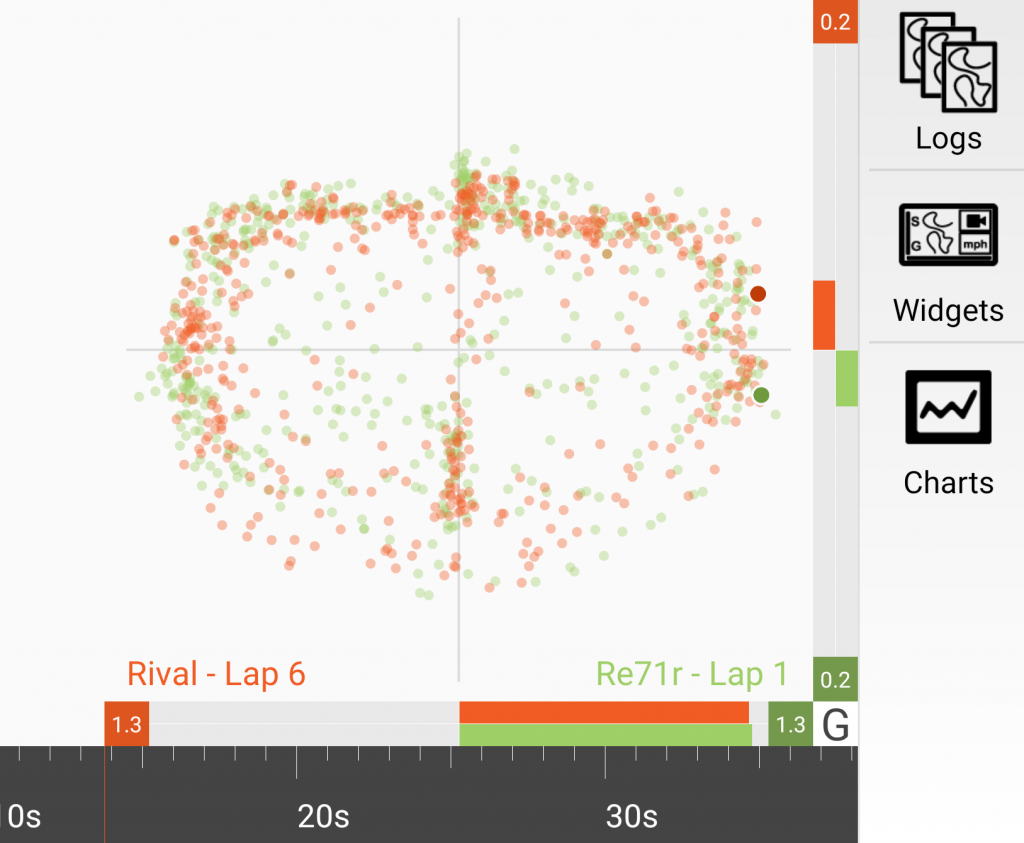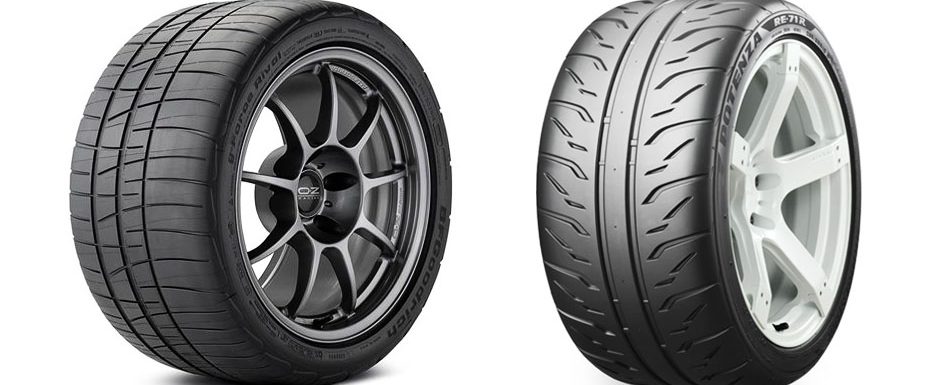In case you missed it, round 1 of this test is here.
Last time, on medium grip asphalt, the Bridgestone RE71R edged out the BFGoodrich Rival-S 1.5 by 0.3 seconds on my 2009 Corvette Z06 prepped for A-Street (front sway bar, double adjustable shocks).
For round 2, a couple of things were different:
- I made some shock adjustments that have made the car much better behaved in high speed transitions, and…
- More importantly, this test was done on high grip concrete. The airport concrete at this site is very similar in grip and feel to what we see at the SCCA Autocross National Championships in Lincoln Nebraska.
Before going any further, I’m going to repeat the caveat from last time: Everyone has their own ideas of the “proper” way to test tires. Given unlimited runs, unlimited time, the ability to setup my own test course, etc etc, I would have done things differently. But given that my testing was during the course of a regular autocross event, I had to work within the confines of the circumstances. If you’re not happy with how I did my testing, that’s totally cool, do your own tests and share your results!
To recap, here are the tires being tested…- Bridgestone RE71R (275/35/18 front, 305/30/19 rear) on OEM Z06 wheels
- BFG Rival-S 1.5 (275/35/18 front, 335/30/18 rear) on Forgestar wheels
Both sets of tires had 6 runs on them from the last test.
The format for the day was one competition heat with 4 runs, followed by fun runs after all of the competition heats had completed. With only 4 competition runs, I didn’t think it would be worth trying to change tires between those runs. So my plan was to run all 4 runs on the Rival-S 1.5, and then do 4 runs during the fun runs on the RE71R, followed by 2 more on the Rival-S 1.5 to bracket the test, in order to ensure that I gave both tires a fair shot.
The course had a very fast start, going from 0-80mph! But after that, the course was in the normal speed range for autocross (30-70mph), with lots of high speed transitions, a couple of thread-the-needle elements, and a handful of sweepers.
I’ll start with listing out the times for each run, and then give my commentary below.
Morning competition runs on the Rival-S 1.5 (29 psi pressure front and rear)
48.033 (+1)
47.185
46.782 (+3)
47.572 (+1)
Afternoon fun runs on the RE71R (30 psi pressure front and rear)
45.7xx
46.2xx
Afternoon fun runs on the Rival-S 1.5 (30 psi pressure front and rear)
47.1xx
46.3xx
The morning began with the weather in the low 70s, overcast skies, with a light breeze. It took the Rival-S 1.5 a couple of runs to get up to temperature, though after the second run, I did have to spray down just the right front tire which was getting really heated up with the course being counter-clockwise. I put in my fastest (dirty) time of the morning on my 3rd run with a 46.7 (+3). I had set a mental target of being able to get to a low 46 on my 4th run, but ended up making two significant errors and slowed down.
A couple of hours passed before the “fun runs” began. For those who may not be familiar with how fun runs usually go, there are no course workers, and so many of the cones end up knocked over. To ensure that I was running on a “good” course, a fellow competitor went out and reset all of the cones before each of my fun runs.
At this point, the weather was still in the mid/low 70s, with overcast skies and a light breeze. I had switched to the RE71R, and on my very first run, I set my fastest time of the day, with a 45.7xx; a full second fastest than my quickest time from the morning. On my second run, I made an error that caused me to slow down. I wanted to take a third run on these tires, but with the day starting to wind down, it was more important to ensure that I switched back to the Rival-S 1.5 to bracket the test. With how much faster I already was on the RE71R tires, I was sure that at least some of the improvement was because of improved track conditions.
The weather had warmed up just a bit to the upper 70s, with a little more sunshine. It took one run to warm up the Rival-S 1.5, but on my second run (and final run of the day), I put in my quickest time on that tire; a 46.3xx.
Despite taking 6 runs on the Rival-S 1.5 and only 2 runs on the RE71R, the delta between the 2 tires on this day was just a bit under 6 tenths of a second, in favor of the RE71R.
I unfortunately lost ALL of the video files from the Go Pro camera, so all I have to show is the video from the phone camera inside the car, which is very shaky. The video below has my fastest run on both sets of tires.
Fastest RE71R run: 45.7xx
Fastest Rival-S 1.5 run: 46.3xx
OVERALL IMPRESSIONS
In round 1 of this test, I had mentioned that the Rival-S 1.5 seemed to show more peak grip, but the RE71R proved faster because I found it easier to place the car accurately, recover from mistakes more quickly, and preferred the handling balance.
With the revised shock settings, I was really happy with the handling balance on both tires! Interestingly, from the “seat of the pants”, even though the Rival-S 1.5 felt like it had better lateral grip, both tires were in the 1.3g range, with the RE71R hitting a slightly higher peak today.

While on this day the RE71R was the faster tire, there are a couple of things to be mindful of:
- Even though it looks like it took the RE71R only two runs to beat the time set after six runs on the Rival-S 1.5, I think it’s pretty safe to say that the four runs from the morning were when track conditions were slower than the afternoon.
- With a few more runs on the RE71R, it is possible I may have gone even faster. Although, the inverse is just as likely. Many people have observed that the RE71R is fastest on the first/cold run, and doesn’t get faster on subsequent runs.
- Given that the Rival-S 1.5 likes some heat, it is entirely possible that had I been able to take a 3rd run on them in the afternoon, it would have gone faster, and closed the gap to the RE71R.
FINAL TAKEAWAYS
I do not consider these 2 rounds of testing to be absolutely conclusive, as the testing was done during the flow of a normal event, and I did not have full control over all of the variables. That said, while the test was not scientifically conclusive, there was certainly an observable trend.
I cannot stress enough that my test results do not necessarily mean that you will see the same results. There are 2 very significant variables you have to consider…
First, is that different cars will react differently to these 2 amazing tires. Based on what I have learned from running these tires on my Corvette, and on an STR S2000 in the past, I believe that the RE71R will benefit cars that need help putting the power down, and will do better on stock (Street category) cars. I believe the Rival-S will be evenly matched, or do better, on cars that don’t need extra help putting the power down (AWD cars, lower powered RWD cars, etc), and on cars in the Street Touring category. I prefer the RE71R on the Corvette, but I preferred the Rival-S on the STR S2000.
Second, is that which tire performs better is HUGELY affected by driving style. The importance of this simply cannot be overstated. If you tend to dive bomb into corners or get on the throttle really aggressively, the slightly better longitudinal prowess of the RE71R may be to your liking. On the other hand, if you brake and get on the gas with more finesse and really maximize the lateral grip you demand from the car, you may do better on the Rival-S.
For me, I am likely going to continue to use both tires; using the RE71R on days when I am a single driver or the weather is under 80 degrees, and using the Rival-S on warmer days when heat tolerance is the winning ticket.

Great job Vivek. I really appreciate you sharing the results of both tests. The “final takeaways” are very illuminating. Well done.
Coming in a little late here, but I was curious what your results were as I am making the choice between these two tires this year. Word of mouth main difference in my region, and potential new set of test parameters, is heat tolerance. Most of our events take place in 85-95F weather on an asphalt surface. The characteristic of the RE-71R to be fastest on the first run is amplified where as the BFG holds out longer. Thank you for a great comparison!
Lucas, for 2019, I ended up running the BFG for Pro Solos (because of their generous contingency, and heat tolerance), and Bridgestone/Yokohama for National Champ Tours. For 2020, I am as of yet undecided which tire I will be on.